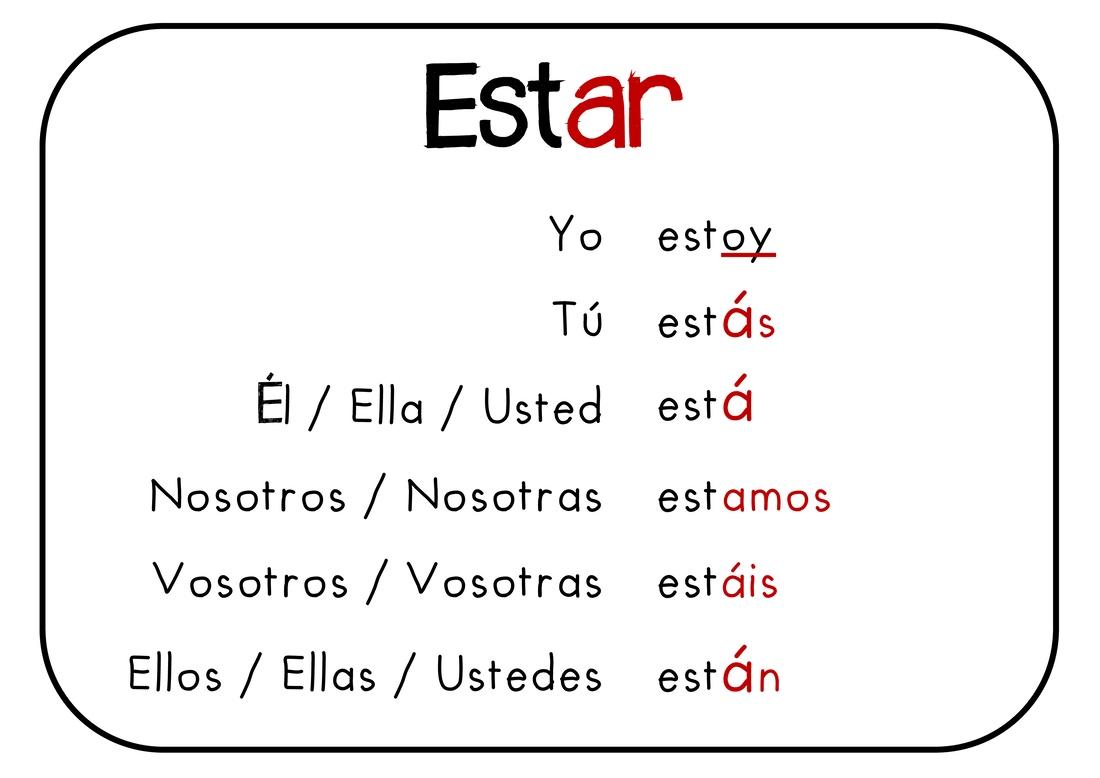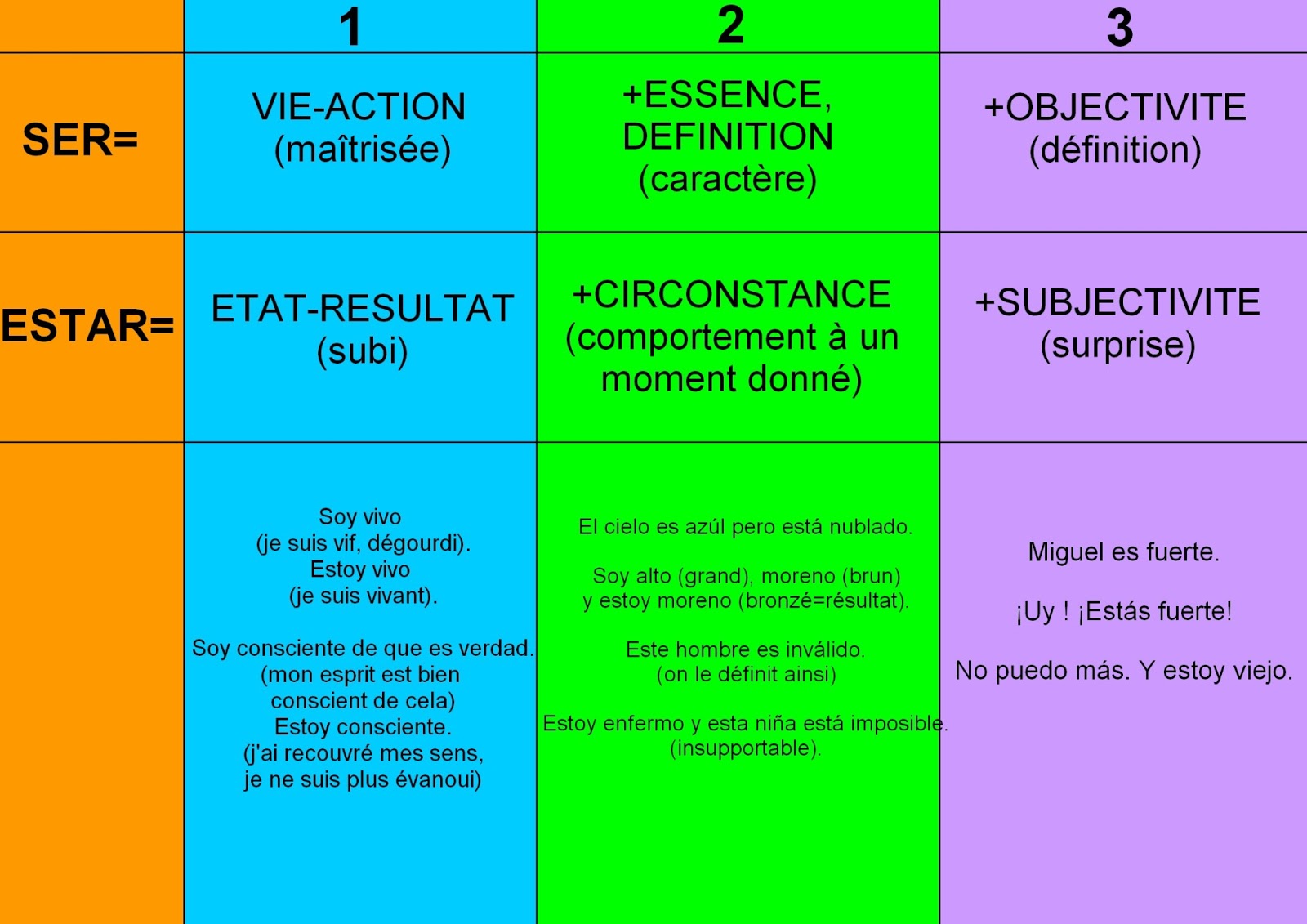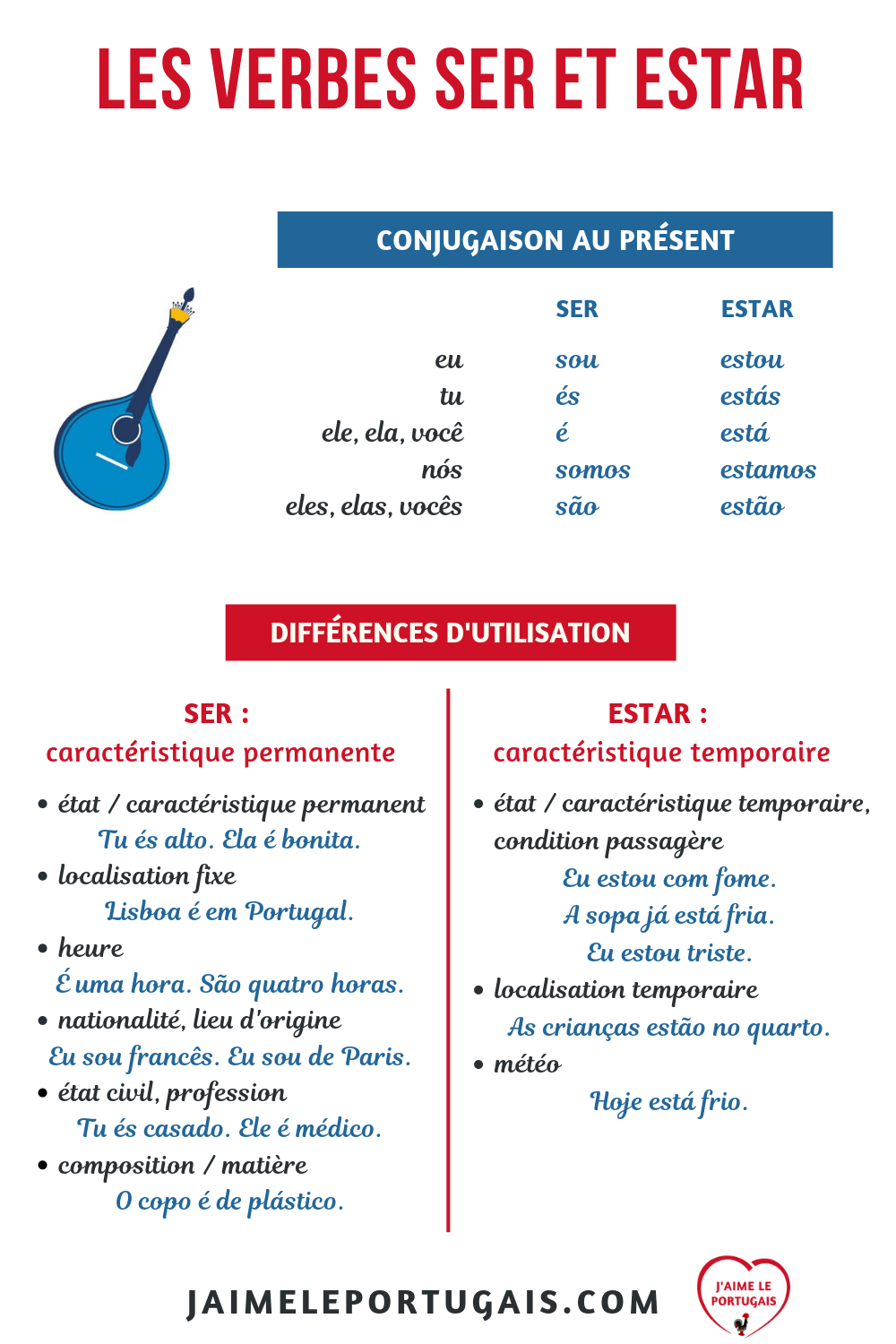
Cool Estar Conjugation References
Ser Estar ser bueno :être bon,gentil estar bueno :être bon à manger ser malo :être mauvais, méchant estar malo :être malade ser rico :être riche estar rico: être savoureux ser atento :être attentionné estar atento :être attentif

Ser_Estar_Infografia Ecole Cervantes
Ser Chart Spanish Usage Examples of Ser. Ser in Spanish can be used in different scenarios: Ser can be used to indicate someone's profession or occupation: Marta es veterinaria. Marta is a vet. Carlos y Joel son consejeros. Carlos and Joel are advisers . Ser can be used to indicate nationality or religion: Lucía es española. Lucia is Spanish.

El Verbo Estar Senora Engle's Clase de Espanol
Estar describes temporary conditions or states, locations, and actions happening at the moment of speaking ( estar + gerundio). Learn the difference between ser and estar with Lingolia then practise in the exercises. How to conjugate ser and estar The tables below show the conjugations of ser and estar in the important Spanish tenses. ser estar

Emplois de Ser et Estar Espagnol YouTube
Ser/Estar - La conjugaison espagnole ser estar Comment les conjuguer ? Quand les employer ? Adjectifs utilisés avec ser/estar Exercices en ligne pour apprendre l'espagnol Lingolia Plus Espagnol Tu souhaites passer directement à la pratique ? Clique ici. Ser et Estar : quel verbe choisir ?

Comment utiliser “ser” et “estar” en espagnol ? TLCdénia
En pocas palabras, ser se utiliza para hablar de estados permanentes, mientras que estar se utiliza para hablar de condiciones temporales. En inglés, se usaría el verbo "to be" para ambos casos, pero en español ambos verbos tienen significados algo diferentes. Otra forma de explicar su diferencia es que ser habla sobre qué es algo y.

Verbe être en espagnol. SER ou ESTAR. Manière mnémotechnique pour apprendre à les différentier
Ser/Estar Ser Get more practice with Lingolia Plus! hundreds of additional exercises organised by topic and level no subscription Ser Ser + adjective The following list shows the most important adjectives that take ser.

El presente de Ser Estar Ap Spanish, Spanish Grammar, Spanish Class, Spanish Lessons, Teaching
to be. Spanish verbs Cheat Sheet Practice conjugating ser Participles Include vos Include vosotros Indicative of "ser" Irregularities are in red Want to Practice Conjugations? Present 0/8 lessons Subjunctive 0/12 lessons See All Lessons Subjunctive of "ser" Imperative of "ser" Progressive of "ser" Perfect of "ser" Perfect Subjunctive of "ser"

SER et ESTAR Tout ce que tu dois savoir sur le verbe ÊTRE en espagnol Espagnol à la Maison
DIFERENCIAS DE LOS VERBOS SER Y ESTAR. Las diferencias de estos verbos son muy claras ya que "ser" se usa para hablar de estados o cosas permanentes, mientras que "estar" se utiliza para referirnos a condiciones temporales. Así es que nos damos cuenta que los verbos ser y estar en español son muy diferentes al verbo "to be" en.

ejercicios de ser estar Spaans Pinterest Ejercicios, Ejercicios de gramatica y Gramática
Estar ¿Cuándo se usan los verbos ser y estar? Ser El verbo ser se emplea en español en las siguientes situaciones: apariencia física o rasgos de la personalidad; Ejemplo: Félix y Raúl son altos. Antón es muy simpático. identidad o rasgos identificativos; Ejemplo: Yo soy Santiago. Este es el Teatro Real. La familia de Carlos es católica. el origen;

5 erreurs à éviter en espagnol Ecole Cervantes
Emotion. Estoy triste. I am sad. Estoy triste. I am sad. Captions 9-10, El Aula Azul - Estados de ánimo. Play Caption. Finally, we want to leave you with a little rhyme that will help you to choose the appropriate verb between ser and estar. This little rhyme, which is quite handy for the verb estar, goes like this:

Ser Estar / There are two verbs that mean to be in spanish, ser ultimately, the best way to
Review Time: if you're not sure how to conjugate these two important verbs (they're irregular), check out the verb conjugation tables for ser and estar.. Uses of Ser. Ser is used to talk about permanent or lasting attributes.If this general rule is too vague for you, think of the acronym DOCTOR, which stands for Descriptions, Occupations, Characteristics, Time, Origin, and Relationships.

Soutien Espagnol Lycée Elisa Lemonnier Primera lección Ser y Estar
El verbo ESTAR habla de los estados de las personas o de las cosas. Por ejemplo: «Mi amiga está contenta, está feliz». «La pizarra está sucia, o está limpia». Otra diferencia importante entre SER y ESTAR: El verbo SER se utiliza para hablar de la profesión habitual, es decir, la profesión de la persona. Por ejemplo: «Yo soy profesora.

Aprenda Español Ser, Estar, Ir/ To be, To go Spanish ser, Conjugation chart, Elementary spanish
¡Así estaremos todos juntos! When to use ser and estar in Spanish grammar Although the verbs ser and estar can be translated into English as be, these verbs actually have distinct uses in Spanish: Ser The verb ser is used for the following: inherent/identifying physical characteristics and personality traits Examples: Félix y Raúl son altos.

verbe tener en espagnol au présent
Utilizo el verbo SER para describir la CARACTERÍSTICA ESENCIAL de la persona o de la cosa. Las características esenciales normalmente son permanentes. El verbo ESTAR, por lo contrario, NO habla de la característica, sino del ESTADO de una persona o de una cosa. También lo utilizamos para hablar de la LOCALIZACIÓN EN EL ESPACIO.

SER y ESTAR Learn Spanish Easily with AIL Málaga Spanish language, Spanish language school
Estar < stare (être debout, se dresser) : L'état locatif/spatial, animique, accidentel… On associe traditionnellement ser / estar parce qu'ils renvoient à un même verbe être dans d'autres langues (fr. être, ang. to be, all. sein ).

Pin on ELE
El verbo estar habla también de los estados de ánimo de las personas, de sus emociones y sus sentimientos. Son estados temporales que cambian, no son duraderos y todas las personas los experimentamos. Hablamos de sensaciones que pueden ser pasajeras o pueden tener una causa puntual, es decir, no definen a la persona.